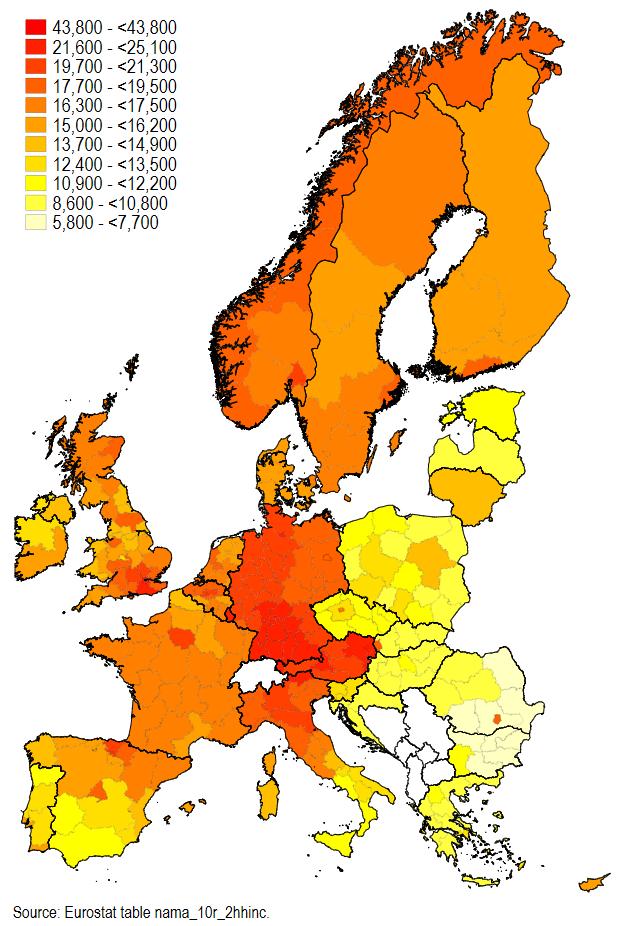
Credit: IIASA
As the COVID-19 pandemic sweeps across the globe, it is fast becoming clear that no one is exempt from its disruptive effects. IIASA researchers are working to visualize key demographic and socioeconomic information to help inform decisions by health professionals, governments, and policymakers to address the crisis.
Since first recorded in China towards the end of 2019, COVID-19 has spread around the world, with Europe fast becoming one of the worst-affected regions. Initial statistics on the pandemic suggest that the 65 plus and especially 80 plus age group face the highest risk, which is of particular concern as the EU is home to a large aging population, as well as considerable variations across regions in terms of economic development. The combination of these two points implies that different regions face different challenges in terms of the spread of the virus, the burden on countries’ public health and social security systems, and economic losses. IIASA researchers have been tracking the progression of the pandemic across the region and have made available maps that visualize key demographic and population information to help inform decisions by health professionals, governments, and policymakers.
“The rapid spread of the virus has forced many countries to take drastic measures like shutting down public spaces, schools, and businesses, in an effort to limit mobility and human interaction. These measures are collectively referred to as “social distancing” and they are based on the premise that the less interactions there are among people, the slower the virus spreads, and the better the health care system is capable of handling it. To know whether measures are working and for how long they need to be kept in place, decision makers however need information to help inform their decisions. As we find ourselves in an unprecedented situation, this information is not always readily available. This project aims to help fill this gap,” explains Asjad Naqvi, project lead and a researcher in the Advanced Systems Analysis Program at IIASA.
The series of user-friendly maps visually explores a variety of demographic, socioeconomic, and health-related indicators, including migration and population changes, average household income, and the number of doctors and hospital beds available in each EU country. The visualizations are compiled using selected indicators from the publicly available Eurostat database and will be regularly updated to reflect changes in reported cases. The team plans to continue expanding the current list of indicators to aid efforts to better understand the socioeconomic and demographic contexts under which the current COVID-19 crisis is unfolding. Work is also currently underway on an interactive website that will serve as a repository of all IIASA research related to COVID-19 and a platform to view and browse the latest updates, as well as historical versions of the maps.
“The extent of our interconnectedness has led us to recognize that we live in a global village, and this pandemic has removed any remaining doubts. However, the underlying global order of pervasive tourism, trade, business, and education has the potential to create vulnerabilities, while at the same time presenting an opportunity to generate critical sector specific information that could be systematically harnessed to allow rapid and effective global and national responses to risks,” concludes IIASA Deputy Director General for Science, Leena Srivastava.
###
Reference
Naqvi A (2020). COVID-19: Visualizing regional socioeconomic indicators for Europe. International Institute for Applied Systems Analysis (IIASA), Laxenburg, Austria [pure.iiasa.ac.at/16395]
More information:
iiasa.ac.at/covid19maps
Contacts:
Researcher contact
Asjad Naqvi
Research Scholar
Advanced Systems Analysis Program
Tel: +43 2236 807 575
[email protected]
Press Officer
Ansa Heyl
IIASA Press Office
Tel: +43 2236 807 574
Mob: +43 676 83 807 574
[email protected]
About IIASA:
The International Institute for Applied Systems Analysis (IIASA) is an international scientific institute that conducts research into the critical issues of global environmental, economic, technological, and social change that we face in the twenty-first century. Our findings provide valuable options to policymakers to shape the future of our changing world. IIASA is independent and funded by prestigious research funding agencies in Africa, the Americas, Asia, and Europe. http://www.
Media Contact
Ansa Heyl
[email protected]
Original Source
https:/




